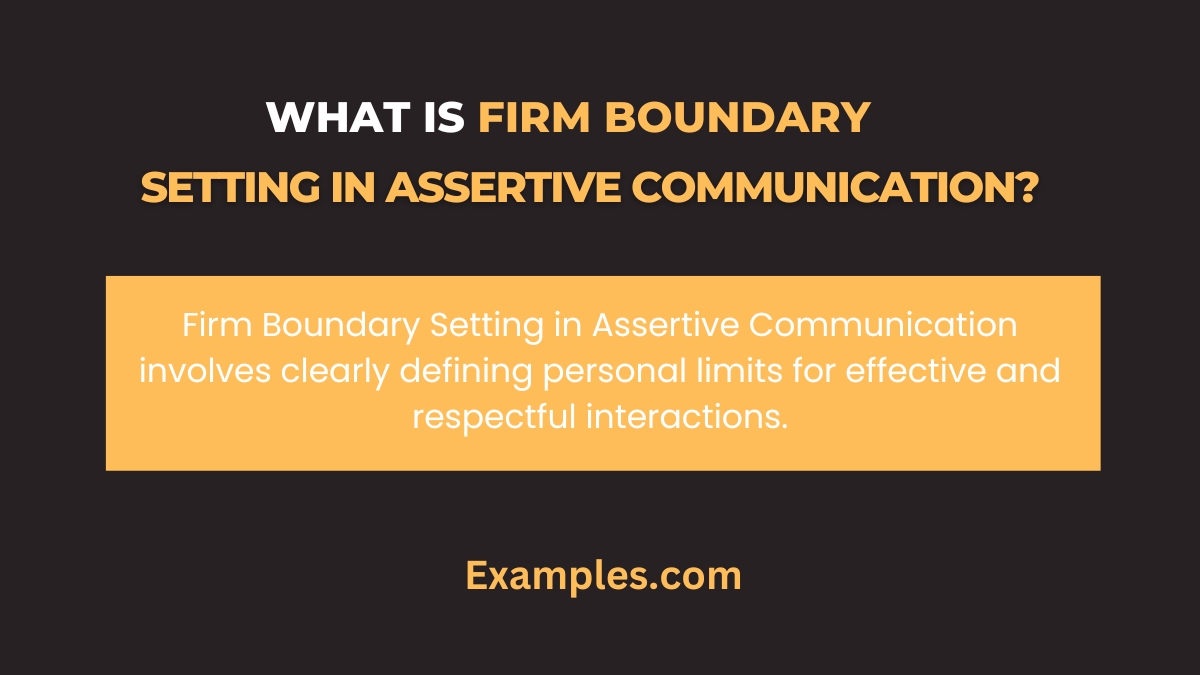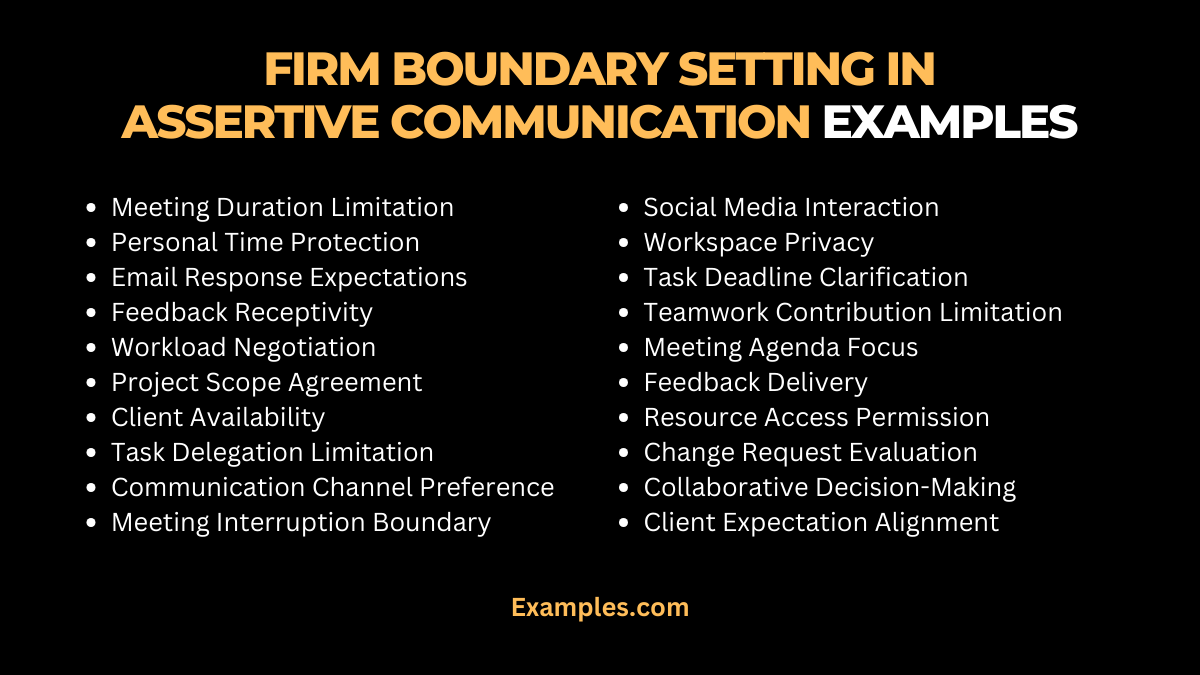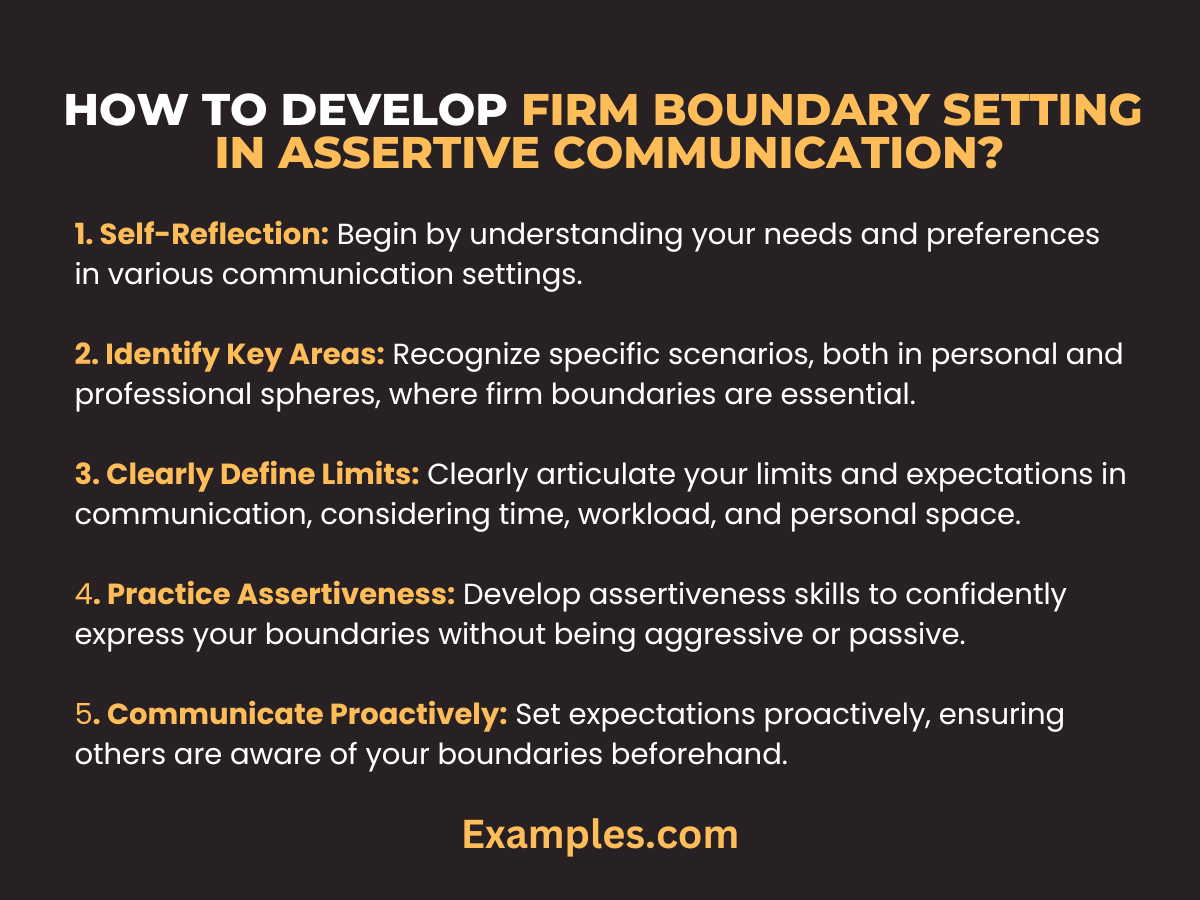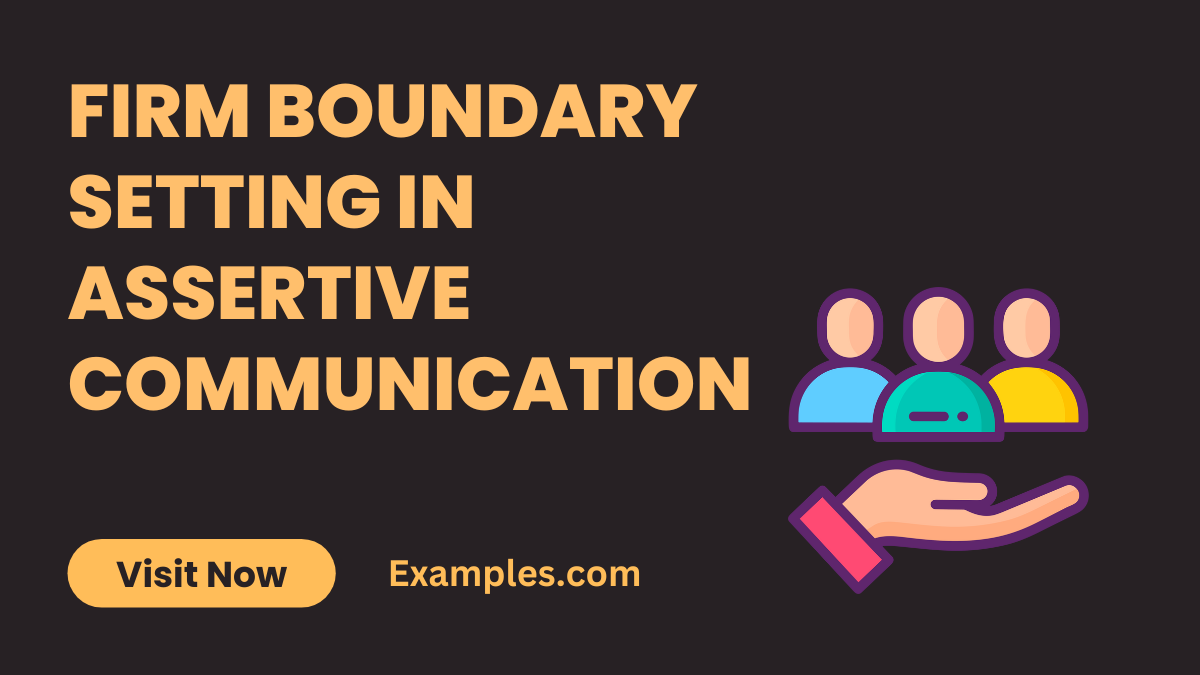19+ Firm Boundary Setting In Assertive Communication Examples
Embark on a journey to master the art of Firm Boundary Setting in assertive communication. Explore practical insights, real-life examples, and actionable tips to enhance your interpersonal skills. Uncover the key to effective communication and navigate various scenarios with confidence. This comprehensive guide is designed to empower you with the tools needed to establish and maintain firm boundaries in diverse communication settings.
What is Firm Boundary Setting In Assertive Communication?

Firm Boundary Setting in assertive communication is the proactive establishment of clear and respectful limits in interpersonal interactions. It involves expressing personal needs, expectations, and limits assertively to ensure healthy communication dynamics. This approach fosters mutual understanding, builds trust, and contributes to a positive communicative environment. By incorporating Firm Boundary Setting, individuals can navigate conversations confidently while maintaining respect for themselves and others.
20 Firm Boundary Setting In Assertive Communication Examples

Unlock the art of effective communication with assertive boundary setting. Here are 20 practical examples to guide you:
- Meeting Duration Limitation: Communicate: “I appreciate your input, but let’s adhere to the scheduled meeting duration for efficiency.”
- Personal Time Protection: Express: “While I value collaboration, I need personal time after work; let’s avoid non-urgent discussions after hours.”
- Email Response Expectations: Set the Boundary: “To manage my workload, I’ll respond to emails within 24 hours; your understanding is appreciated.”
- Feedback Receptivity: Assert: “I welcome constructive feedback, but let’s discuss it during our designated feedback sessions.”
- Workload Negotiation: Communicate Clearly: “I’m committed, but let’s discuss workload adjustments for better productivity.”
- Project Scope Agreement: Set Expectations: “To meet deadlines, let’s agree on a clear project scope from the beginning.”
- Client Availability: Express Clearly: “I value client collaboration, but let’s schedule meetings during business hours for efficiency.”
- Task Delegation Limitation: Communicate Assertively: “While I’m willing to help, let’s set reasonable limits on task delegation.”
- Communication Channel Preference: Express Preferences: “For urgent matters, let’s communicate via phone; emails for less urgent issues.”
- Meeting Interruption Boundary: Assert Your Needs: “While I encourage participation, let’s minimize interruptions for a focused discussion.”
- Social Media Interaction: Set the Rule: “I enjoy socializing, but let’s keep professional discussions on work-related platforms.”
- Workspace Privacy: Communicate Boundaries: “I appreciate collaboration, but let’s respect individual workspace privacy.”
- Task Deadline Clarification: Be Clear: “To ensure quality, let’s discuss realistic deadlines for task completion.”
- Teamwork Contribution Limitation: Assert*: “While I value teamwork, let’s set realistic expectations for individual contributions.”
- Meeting Agenda Focus: Express Clearly: “To optimize our time, let’s stick to the meeting agenda; off-topic discussions can be addressed separately.”
- Feedback Delivery: Set the Tone: “Constructive feedback is welcome; let’s ensure it’s delivered respectfully and privately.”
- Resource Access Permission: Communicate Assertively: “To maintain security, let’s limit access to sensitive resources; seek permission as needed.”
- Change Request Evaluation: Express Clearly: “While changes are considered, let’s evaluate and prioritize them for efficiency.”
- Collaborative Decision-Making: Set the Expectation: “While I value input, let’s make final decisions collaboratively after thorough discussion.”
- Client Expectation Alignment: Communicate Clearly: “To manage expectations, let’s align client requests with realistic timelines and capabilities.”
Firm Boundary Setting In Assertive Communication Examples For Student
Embark on a journey of effective communication in a student setting. Implement assertive boundary-setting with these practical examples:
- Assignment Group Contributions: Communicate: “I appreciate collaboration, but let’s ensure fair distribution of work among group members.”
- Study Group Time Limits: Set Expectations: “While I value study groups, let’s agree on time limits to maximize productivity.”
- Peer Feedback Receptivity: Assert Your Needs: “I welcome feedback, but let’s discuss it constructively during designated feedback sessions.”
- Personal Study Time Protection: Express Clearly: “For focused studying, let’s minimize interruptions during designated personal study hours.”
- Collaborative Project Scope: Communicate Boundaries: “To manage tasks effectively, let’s define a clear scope for collaborative projects.”
- Classroom Participation: Assertive Communication: “While I value discussions, let’s allow each student to express their thoughts without interruption.”
- Group Study Session Privacy: Set the Rule: “To respect individual study methods, let’s maintain a quiet environment during study sessions.”
- Social Media Boundaries: Communicate Assertively: “For academic discussions, let’s use appropriate platforms and keep social media interactions professional.”
- Library Collaboration Limits: Be Clear: “While I enjoy collaboration, let’s maintain silence in the library for the benefit of all students.”
- Presentation Contribution Expectations: Express Preferences: “To ensure fair contributions, let’s establish expectations for each member during group presentations.”
Firm Boundary Setting In Assertive Communication Examples at Workplace
Navigate workplace dynamics effectively with assertive communication. Implement firm boundary-setting using these practical workplace examples:
- Meeting Time Efficiency: Assert Your Needs: “While I value meetings, let’s aim for efficiency by adhering to the scheduled time.”
- Work-Life Balance Conversation: Communicate Clearly: “I appreciate collaboration, but let’s avoid work discussions outside business hours for personal time.”
- Email Response Expectations: Set Expectations: “To manage my workload, I’ll respond to non-urgent emails within 24 hours; your understanding is appreciated.”
- Task Delegation Limitation: Express Preferences: “While I’m willing to help, let’s set reasonable limits on task delegation to maintain efficiency.”
- Workspace Privacy: Assertive Communication: “I value collaboration, but let’s respect individual workspace privacy for focused work.”
- Project Scope Agreement: Communicate Boundaries: “To meet deadlines, let’s agree on a clear project scope from the beginning.”
- Client Meeting Availability: Set the Rule: “I value client collaboration, but let’s schedule meetings during business hours for efficiency.”
- Task Deadline Clarification: Be Clear: “To ensure quality work, let’s discuss realistic deadlines for task completion.”
- Feedback Receptivity: Communicate Assertively: “I welcome constructive feedback, but let’s discuss it during our designated feedback sessions.”
- Teamwork Contribution Limits: Express Preferences: “While I value teamwork, let’s set realistic expectations for individual contributions for project success.”
What Happens When You’re Setting Firm Boundaries In Assertive Communication?
Establishing firm boundaries in assertive communication enhances clarity, respect, and mutual understanding. It fosters a positive environment where expectations are clearly defined, leading to improved relationships and more effective communication.
How to Develop Firm Boundary Setting In Assertive Communication?

Establishing firm boundaries in assertive communication is crucial for maintaining healthy interactions. Here’s a comprehensive guide on developing effective boundaries:
- Self-Reflection: Begin by understanding your needs and preferences in various communication settings.
- Identify Key Areas: Recognize specific scenarios, both in personal and professional spheres, where firm boundaries are essential.
- Clearly Define Limits: Clearly articulate your limits and expectations in communication, considering time, workload, and personal space.
- Practice Assertiveness: Develop assertiveness skills to confidently express your boundaries without being aggressive or passive.
- Communicate Proactively: Set expectations proactively, ensuring others are aware of your boundaries beforehand.
- Consistent Reinforcement: Regularly reinforce your boundaries, ensuring they are respected over time.
- Adaptability: Be open to adjusting boundaries as needed, considering changing circumstances and priorities.
- Seek Mutual Understanding: Encourage open dialogue to establish mutual understanding of boundaries within relationships or teams.
- Consider Others’ Boundaries: Acknowledge and respect the boundaries of others, fostering a culture of reciprocal communication.
- Regular Self-Evaluation: Periodically assess and adjust your boundaries based on evolving needs and experiences.
Tips for Effective Firm Boundary Setting In Assertive Communications
- Self-Reflection: Begin by identifying your needs and limits.
- Clear Communication: Express boundaries assertively and clearly.
- Consistency: Reinforce boundaries consistently to establish expectations.
- Active Listening: Listen actively to others’ boundaries for mutual understanding.
- Respect: Cultivate a culture of respect for individual boundaries in communication.
Effective firm boundary setting in assertive communication is crucial for healthy interpersonal relationships and professional interactions. This skill empowers individuals to articulate their needs and limits clearly and respectfully, fostering a balanced and constructive communication environment. It not only helps in avoiding misunderstandings but also strengthens mutual respect and trust. Practicing firm boundary setting can lead to improved self-esteem and more fulfilling relationships, as it encourages a culture of open and honest communication where everyone’s needs are acknowledged and valued.
For those seeking to deepen their understanding and skills in assertive communication and boundary setting, exploring additional resources can be highly beneficial. The American Psychological Association offers a wealth of information on assertiveness and healthy communication practices. Furthermore, the University of California, Berkeley’s Greater Good Science Center provides insightful articles and research on the psychology of assertive communication and its impact on relationships and wellbeing. These resources offer valuable perspectives and practical advice for effectively implementing firm boundary setting in various aspects of life.



